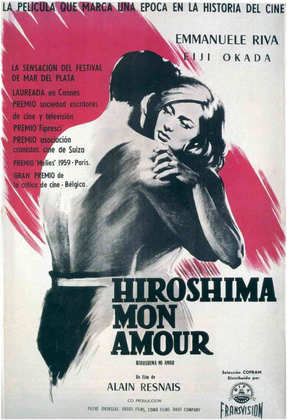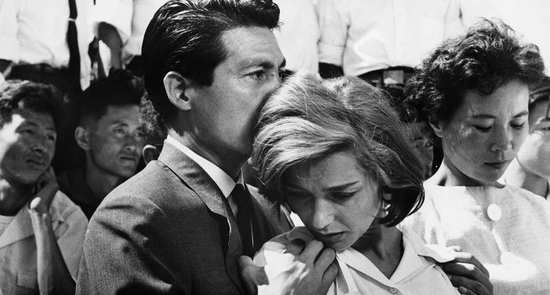Review for Hiroshima Mon Amour
Alain Resnais’ first feature, which novelist André Malraux acclaimed as the most beautiful film he had ever seen, brought Resnais instant fame and has become an enduring classic of film history. It was arguably one of the most refreshingly original films ever made, referencing virtually nothing that preceded it, and it certainly remains a highly influential film to this day.
A complex study of a troubled relationship set in post World War II Japan. Emmanuelle Riva (Amour) stars as a young French actress who is in Hiroshima for the shooting of a film about peace. She meets a Japanese architect, played by Eiji Okada (The Ugly American), who reminds her of a former lover, a German soldier. The haunting affair is overshadowed by memories of the Bomb. It was scripted by acclaimed novelist Marguerite Duras (The Lover).
The film may be set in 'Hiroshima', and the ghosts of that terrible occurrence are omni-present throughout, but this is essentially an bitter-sweet existential journey into the futility of love. And like you, I can't believe I just said that. But this film will do that to you.
A French actress (played highly convincingly by Emmanuelle Riva) is filming a feature film about peace in Japan and whilst on location in Hiroshima she has an affair with a handsome Japanese architect (Eiji Okada). As the couple deepen the intensity of their relationship, the actress recalls her own painful memories of the war where her lover, a German soldier in occupied France, was shot and she was seen as collaborator by her friends and neighbours.
According to Resnais himself, the film started off in the same vein as his moving holocaust documentary, 'Night and Fog' and was initiated as an anti-nuclear weapon documentary. The powerful opening of the film (juxtaposing every day 'love-making' with records of the horrors wreaked by the bomb on Hiroshima and its inhabitants) can easily be seen in this context. Indeed, one of the film's most memorable images is that of what appears to be the sand -covered limb of a dead victim - until it moves. And we see, as the camera pulls out, that it is two people in an embrace.
But whilst Resnais was happy to pick up most the accolades for one of the most successful art-films in a decade full of them, Marguerite Duras' script must surely take some of the credit as it was written in full before Resnais adopted it.
Much of the film is about the importance of remembering - but also of getting in with life regardless; a real dichotomy for Emmanuelle Riva's character who still feels guilty about her German partner and wonders if her affairs are just a way to try and revive his memory to some degree. Or is the intoxicating escape of sex helping to dull the pain for just a few brief moments of bliss where no other thought or responsibility can pervade?
And what of her partner? He appears to be a bit part player in her life. This film is about her after all. But what does he get out of the relationship? Surely more than merely the escapism of mutually enjoyable sex? Whatever the case, it remains a thought-provoking piece.
As well as pioneering the rise of New Wave cinema, this was arguably a turning point in Alain Renais’ career, consolidating his already established reputation for directing short films, including the controversial documentary Night and Fog, set in two abandoned Nazi concentration camps. It paved the way for Renais’ award-winning career, including acclaimed films Last Year at Marienbad and Smoking / No Smoking, which stretched six decades until his death in 2014.
The DVD edition released a couple of years ago was very reasonable but this 4K restoration looks really special on Blu-Ray, maybe not quite worth a double-dip but certainly the edition to go for if you’re buying it for the first time.
This edition also comes with a couple of contextual extras, missing from the previous DVD release.
The first is a contemporary interview with Emmanuelle Riva who remembers the film and working with Renais who she clearly much admires. There’s also a featurette about the fastidious restoration of the film.
It may be a little ‘arty’ for some tastes and doesn’t make for easy viewing in any respect, but it’s unarguably a powerful piece of cinema which has really never looked better.





































Your Opinions and Comments
Be the first to post a comment!